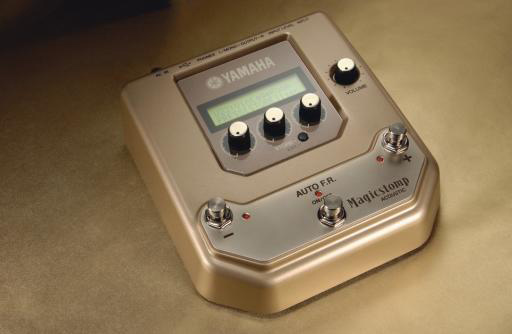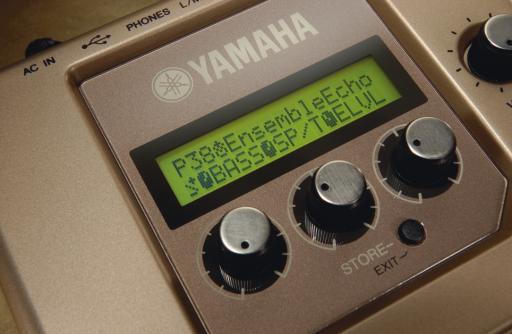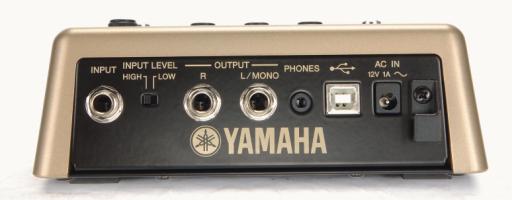MusicRadar Verdict
The Magicstomp Acoustic is likely to find plenty of admirers in the home studio fraternity, but it´s also a great tool for quickly summoning up live settings.
Pros
- +
Perfect for home studio. Convincing ‘mic’d’ acoustic sounds. Upgraded editing features.
Cons
- -
As with any multi-FX, you’ll have to edit many patches to your own. Some presets are a little bass-heavy. Check the software compatibility to make sure it works with your OS first.
MusicRadar's got your back



The Yamaha Magicstomp's compact dimensions, user-friendly operating system and high-quality sounds have made it a popular buy. Yamaha has now released the Mark 2 range, of which this is the acoustic version. It´s designed primarily for steel string acoustics, but has a smattering of presets suitable for nylon string guitars and Yamaha´s ‘silent´ violin and cello.
The basic layout is exactly the same. Switching the unit on takes you to Up/ Down mode, where the left and right footswitches scroll up and down through the presets and the middle footswitch turns the whole patch on or off. With the acoustic version, though, there´s a new feature.
For patches featuring the ‘AcousticMulti´ effect module, the middle footswitch is used to activate Auto Feedback Reduction (AFR). This is a notch filter, designed to cut the frequency causing feedback (usually in a live situation), and up to five frequency bands can be filtered simultaneously. As before, holding down the middle footswitch engages the built-in tuner. In Performance mode (engaged by pressing and holding any two switches), the presets are grouped in sets of three, and the outer footswitches scroll up or down, three patches at a time.
Whichever mode you´re in, you have instant access to three patch parameters as well as a master level control for the unit as a whole. There´s also a two-position input gain
switch. As with the original Magicstomp, there´s no input gain rotary control, but there is an overall level output control.
Deep editing
As before, there´s a USB connection, allowing you to connect the Magicstomp to your computer for accessing ‘deep editing´ functions. The Sound Editor software is very easy and enjoyable to use, but you´ll need the right OS. According to the specifications, most flavours of Windows are supported but Mac compatibility is a little less universal: check out Yamaha's dedicated Magicstomp website for support.
Want all the hottest music and gear news, reviews, deals, features and more, direct to your inbox? Sign up here.
If you can make use of the USB connection, though, you´ll be able to download new patches or firmware updates from the aforementioned website, and you could feasibly download the whole collection of acoustic patches and install them on a standard Magicstomp Mark 2.
Not everyone can (or will) hook up to a PC, so the Mark 2 Magicstomps now allow you to sample the delights of deep editing from the unit itself. Hitting the Store/Exit button, followed by the middle footswitch, allows you to use the left/right footswitches to scroll through all available parameters for a patch. You can still only have three on display at once, but it´s a pleasant compromise between the two original editing methods.
In use
The Magicstomp Acoustic can be run in mono into an acoustic amp or in stereo into a mixer or recording device. With an amp, the results will be less predictable; you´ll hear the effects of the Magicstomp´s digital modelling far more clearly if you go direct into a mixer or recording unit.
The preset list is clearly divided into sections. First of all, you run through a number of barebones examples emulating the sound of three microphone types: condenser, tube and dynamic. These three basic types are then explored later on, adding reverb, room, slapback, echo, delay and ambience to each microphone type in turn. Then there are a whole load of presets aimed at different styles of music, and finally a number of settings for other instruments: 12-string, pedal steel, mandolin and nylon string guitar, to name just a few.
Going through most of the steelstring presets and recording lots of little snippets with a piezo-equipped Washburn guitar, it's clear that the quality of your guitar´s pickup and preamp obviously plays a major part (as will the acoustic resonances), but we were instantly impressed.
Some of the presets are a little bass-heavy, which didn´t help alleviate the natural ‘thump´ of the under-saddle pickup, but most have a very believable ‘mic´d´ sound. The Vintage setting (designed to emulate a valve mic) was our favourite, especially with a smattering of reverb.
MusicRadar is the number 1 website for music makers of all kinds, be they guitarists, drummers, keyboard players, djs or producers...
GEAR: We help musicians find the best gear with top-ranking gear round-ups and high- quality, authoritative reviews by a wide team of highly experienced experts.
TIPS: We also provide tuition, from bite-sized tips to advanced work-outs and guidance from recognised musicians and stars.
STARS: We talk to musicians and stars about their creative processes, and the nuts and bolts of their gear and technique. We give fans an insight into the actual craft of music making that no other music website can.
